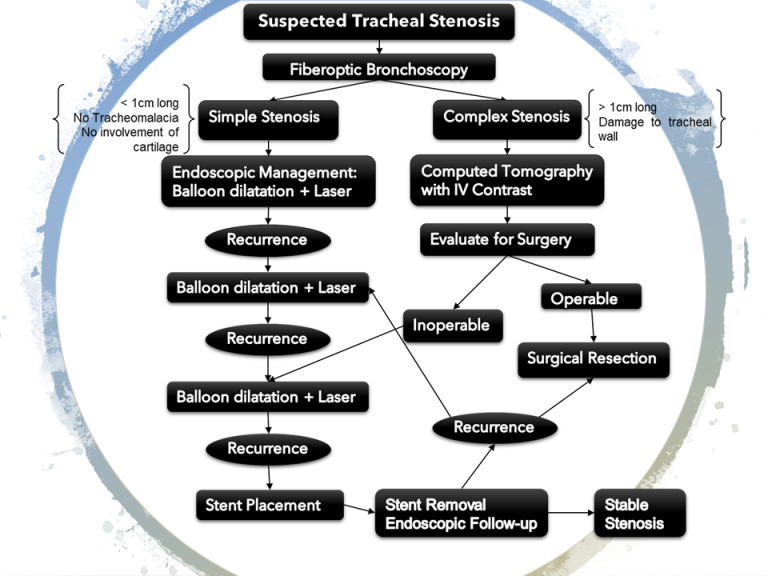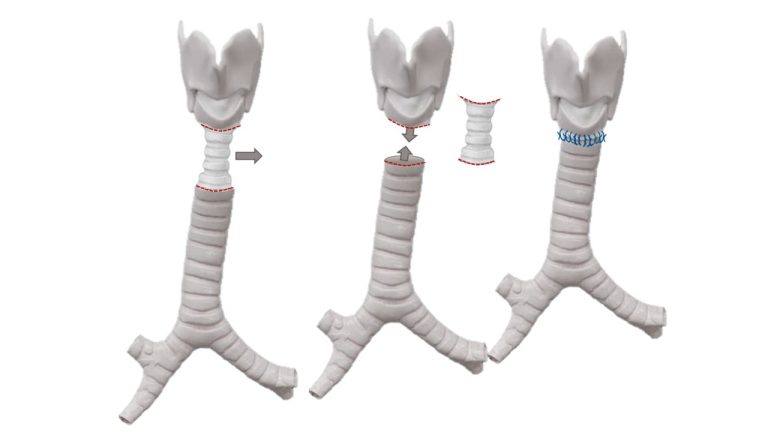Tracheal Resection at Panorama Centre for Surgical Oncology
Tracheal Stenosis

Tracheal stenosis is a narrowing of your trachea (windpipe). It has several causes such as the development of scar tissue or damage to the cartilage in the trachea wall.
The most common causes of tracheal stenosis are:
- Prolonged placement of an endotracheal tube (breathing tube) or tracheostomy
- Inflammatory bowel disease
- Collagen vascular disease (granulomatosis with polyangiitis)
- Congenital malformations (birth defect)
- Trauma
- Inhalation burns
- Radiation therapy
- Infections of the trachea
- Inflammatory diseases (sarcoidosis or amyloidosis)
- Cancer
Treatment of Tracheal Stenosis
Tracheal stenosis is best treated by a team of doctors who regularly manage this condition.
Dr Ettienne Myburgh, with interventional pulmonologists, Drs Johan Theron and Morne Vorster is one of the very few multidisciplinary teams in South Africa providing integrated management for tracheal stenosis, treating patients from all over Southern Africa.
Several factors are considered before deciding on your treatment options such as:
- The tightness of the stenosis,
- The location of the narrowed area.
- What caused the stenosis
Treatment options available
Endoscopic tracheal dilation.
We use a bronchoscope to place an inflatable balloon in your trachea. The balloon stretches the narrowing so you can breathe. Bronchoscopy also provide more information about the narrowing in your trachea. This is most appropriate for short segments of stenosis which does not affect the cartilage rings of the trachea
Laser bronchoscopy
Through the bronchoscope, a laser beam can be used to cut through the scar tissue in your trachea to allow dilatation. A needle knife is also used to remove some of the scar tissue.
Trachea airway stent.
A stent is a small plastic or metal mesh tube that is deployed into your trachea to keep the area of narrowing open. Stenting should only be considered once the patient has been considered for surgical resection.
Surgery to remove the narrowed section
Tracheal resection and reconstruction.
On operation is done by making a horizontal incision in the lower neck. The muscles in front of the windpipe is separated and the thyroid is split in the middle and reflected away from the windpipe.
Once the area of tracheal scarring and constriction is isolated, this section is cut away (resected), and the two remaining ends of your trachea are sewn back together resulting in an unobstructed airway.
No stents, tracheostomy tubes of T-tubes are left in the windpipe, and if such devices were present before the operation, it is removed during the surgery.
Tracheal resection is highly successful and is considered the modality of choice for complex segments of narrowing.
How effective is surgery for tracheal stenosis?
Tracheal resection and reconstruction surgeries are more likely to eliminate the narrowing in your trachea. Other treatments such as bronchoscopic tracheal dilation and trachea airway stents are often temporary solutions that sometimes become permanent.


